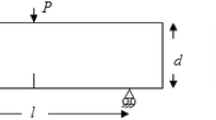Abstract
This paper addresses the use of R-curves to study the fracture behavior of high-strength concrete and steel-fiber-reinforced concrete subjected to crack ing in a three-point bending configuration. The R-curves are modeled through an effective approach based on the equations of linear-elastic fracture mechanics (LEFM), which relates the applied load to the fundamental displacements of notched-through beams loaded monotonically. It is initially shown that, for quasi-brittle materials, the R-curves responses can be evaluated in a quasi-analytical way, using the load-crack mouth opening, the load-load line displacement, or exclusively the displacement responses obtained experimentally. Afterward, the methodology is used to obtain the fracture responses of high-strength and fiber-reinforced concretes, up to the final stages of rupture.
Similar content being viewed by others
References
S. P. Shah, S. E. Swartz, and C. Ouyang, Fracture Mechanics of Concrete — Applications of Fracture Mechanics to Concrete, Rock, and Other Quasi-Brittle Materials, John Wiley & Sons, Inc., New York, USA (1995).
Z. P. Bazant and J. Planas, Fracture and Size Effect in Concrete and Other Quasi-Brittle Materials, CRC Press, Boca Raton, U S A (1998).
A. Hillerborg, M. Modéer, and P. E. Petersson, “Analysis of crack formation and crack growth in concrete by means of fracture mechanics and finite elements,” Cem. Concr. Res. 6, 773–782 (1976).
A. Hillerborg, “The theoretical basis of a method to determine the fracture energy G f of concrete,” Mater. Struct. 18, 291–296 (1985).
Z. P. Bazant and B. H. Oh, “Crack band theory for fracture of concrete,” Mater. Struct., 16, 155–177.
Y. Jenq and S. P. Shah, “Two parameter fracture model for concrete,” J. Eng. Mech. ASCE, 111, No. 10, 1227–1241 (1985).
Y. Jenq and S. P. Shah, “A fracture toughness criterion for concrete,” Eng. Fract. Mech. 21, No. 5, 1055–1069 (1985).
Z. P. Bazant and M. T. Kazemi, “Determination of fracture energy, process zone length and brittleness number from size effect, with application to rock and concrete,” Int. J. Fracture, 44, 111–131 (1990).
B. L. Karihaloo and P. Nalathambi, “An improved effective crack model for the determination of fracture toughness of concrete,” Cem. Concr. Res., 19, 603–610 (1989).
B. L. Karihaloo and P. Nalathambi, “Effective crack model for the determination of fracture toughness (K EIC ) of concrete,” Eng. Fract. Mech. 35, Nos. 4/5, 637–645 (1990).
M. Wecharatana and S. P. Shah, “A model for predicting fracture resistance of fiber reinforced concrete,” Cem. Concr. Res., 13, 819–829 (1983).
C. Ouyang, et al., “An R-curve approach for fracture of quasi-brittle materials,” Eng. Fract. Mech., 37, No. 4, 901–916 (1990).
T. Fett, “Determination of bridging stresses and r-curves from load displacement curves,” Eng. Fract. Mech., 52, No. 5, 803–810 (1995).
H. Tada et al., The Stress Analysis of Cracks, Handbook, Paris Productions Incorporated, St. Louis, U S A (1985).
G. V. Guinea et al., “Stress intensity factor, compliance and CMOD for a general three-point-bend beam,” Int. J. Fracture, 89, 103–116 (1998).
L. E. T. Ferreira, On the Fracture Resistance of Concretes and Fiber-Reinforced Concretes, Doctoral Thesis [in Portuguese], Escola Politécnica, Universidade de São Paulo, Brazil (2002).
L. E. T. Ferreira et al., “R-curve behavior in notched beam tests of rocks,” Eng. Fract. Mech., 69, No. 17, 1845–1852 (2002).
H. Saldivar, Flexural Toughness Characterization of Steel-Fiber-Reinforced Concrete. Doctoral Thesis, School of Civil Engineering (ETSCCPB), Universitat Politécnica de Catalunya, Barcelona, Spain (1999).
Author information
Authors and Affiliations
Additional information
Russian translation published in Mekhanika Kompozitnykh Materialov, Vol. 43, No. 5, pp. 701–710, September–October, 2007.
Rights and permissions
About this article
Cite this article
Ferreira, L.E.T. Fracture analysis of a high-strength concrete and a high-strength steel-fiber-reinforced concrete. Mech Compos Mater 43, 479–486 (2007). https://doi.org/10.1007/s11029-007-0045-8
Received:
Issue Date:
DOI: https://doi.org/10.1007/s11029-007-0045-8




